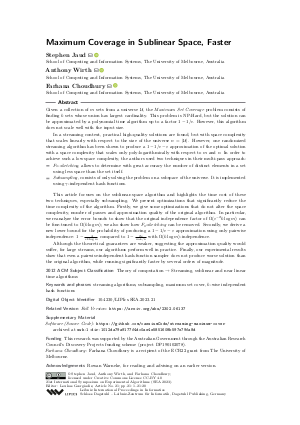@InProceedings{jaud_et_al:LIPIcs.SEA.2023.21,
author = {Jaud, Stephen and Wirth, Anthony and Choudhury, Farhana},
title = {{Maximum Coverage in Sublinear Space, Faster}},
booktitle = {21st International Symposium on Experimental Algorithms (SEA 2023)},
pages = {21:1--21:20},
series = {Leibniz International Proceedings in Informatics (LIPIcs)},
ISBN = {978-3-95977-279-2},
ISSN = {1868-8969},
year = {2023},
volume = {265},
editor = {Georgiadis, Loukas},
publisher = {Schloss Dagstuhl -- Leibniz-Zentrum f{\"u}r Informatik},
address = {Dagstuhl, Germany},
URL = {https://drops.dagstuhl.de/entities/document/10.4230/LIPIcs.SEA.2023.21},
URN = {urn:nbn:de:0030-drops-183715},
doi = {10.4230/LIPIcs.SEA.2023.21},
annote = {Keywords: streaming algorithms, subsampling, maximum set cover, k-wise independent hash functions}
}

 Creative Commons Attribution 4.0 International license
Creative Commons Attribution 4.0 International license

